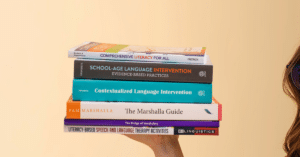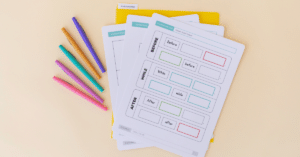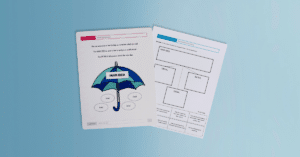Listen on Apple Podcasts Listen on Spotify
This Week’s Episode: How to Target Narratives with Preschoolers Using Literacy-Based Therapy
Evidence shows that using literacy-based therapy to target narratives with preschoolers not only makes sense, but it really helps to set them up for literacy success in the future.
That brings us to this month’s focus: embedding narrative-based skills. The focus of this unit with our Preschoolers will be— answering questions, sequencing, describing, and story retell. Are preschoolers ready to start telling stories? As I was digging through the research, I was more and more convinced that that is something that makes sense to work towards!
We’ll be doing that with the help of the book, Please, Puppy, Please, which is an adorable story about two kids who get a puppy.
Let’s dig into some tips that will make your therapy planning no so…RUFF! 🐶
References
Gillam, S. L., Olszewski, A., Squires, K., Wolfe, K., Slocum, T., & Gillam, R. B. (2018). Improving narrative production in children with language disorders: An early-stage efficacy study of a narrative intervention program. Language Speech and Hearing Services in Schools, 49, 197-212.
Petersen, D. B., & Spencer, T. D. (2016). Using narrative intervention to accelerate canonical story grammar and complex language growth in culturally diverse preschoolers. Topics in Language Disorders.
Nathanson, R., Crank, J. N., Saywitz, K. J., & Ruegg, E. (2007). Enhancing the oral narratives of children with learning disabilities. Reading & Writing Quarterly, 23(4), 315–331.
Here’s what we discussed:
[03:13] Therapy Ideas for Step 1 (Pre-Story Knowledge Activation)
[05:15] Therapy Ideas for Step 2 (Reading)
[05:44] Therapy Ideas for Step 3 (Post Story Comprehension)
[07:20] Therapy Ideas for Step 4 (Skill Practice)
[08:10] Therapy Ideas for Step 5 (Parallel Story)
Want to hear more about this topic? Click here to see this month’s content!
Links Mentioned
– The SLP Now One-Page Literacy-Based Therapy Unit Planner
– Please, Puppy, Please by Spike Lee & Tonya Lewis Lee
– Virtual Field Trip on YouTube
– The SLP Now Membership (The WH Question Cards + Graphic Organizer that we mentioned are included in the membership!)
– Play Therapy Toy Suggestions
Subscribe & Review in iTunes
Are you subscribed to the podcast? If you’re not, subscribe today to get the latest episodes sent directly to you! Click here to make your listening experience auto-magic and as easy as possible.
Bonus points if you leave us a review over on iTunes → Those reviews help other SLPs find the podcast, and I love reading your feedback! Just click here to review, select “Ratings and Reviews,” “Write a Review,” and let me know what your favorite part of the podcast is.
Thanks so much!
Transcript
This week, we are diving into all things preschool and all things narratives. So before we dive into the actual therapy plans, I just wanted to share a couple of the goals that we might be targeting when we're working on narratives with preschoolers. So we might be working on answering questions about a story sequencing or describing picture cards, or to actually retell a story. I'm not going to lie. I was thinking about some of my groups, and I wasn't sure if it would make sense for them. Are they ready to start telling stories? But as I was digging through the research, I was more and more convinced that that is something that makes sense to work towards, and of course we consider each step each student's strengths and needs, and reverse engineer where they are, and where we want them to go, and come up with sub-goals that make sense towards that final action.
But it's definitely something that, there's tons and tons of research out there. There was one study featuring small group narrative intervention with Spanish-speaking preschoolers learning English and that was by Spencer et al in 2019 and 2020. They were absolutely working on narratives with these preschoolers who were just learning English. There was another study by Spencer, Peterson, Slocum and Allen in 2015. They did large group narrative intervention with preschoolers, and they used WH questions as prompts. So that's, again, something we're doing with our preschoolers.
There's tons and tons of studies out there. There's more and more, so those were just a couple that came up. It was also super interesting because Snow et al in 2007 report that the ability to produce a narrative and preschool predicts reading comprehension performance in fourth, seventh, and tenth grade, so this is an important skill that these younger students can be working towards. If we can help them, it is absolutely an inappropriate goal. But again, we get to use our clinical judgment, but I think this was a helpful perspective.
So the book that we're using this month is called Please, Puppy, Please. It's about two kiddos who get a puppy and their experience with that puppy. So let's just dive into the literacy based therapy framework. Well, again, we'll just be focusing primarily on embedding narrative based skills in this unit. So we are working on answering questions, sequencing, describing, and then actually story retell. So for pre-story knowledge, we'll do a book walk, and we'll look at the cover, and flip through some of the pages to see what ... just to get an idea of what kind of schema the students have, or what kind of background knowledge they have around a puppy because that will significantly impact their ability to retell the story.
Have they had a pet? What's their experience with having a pet? Do they not know about having pets as cats and dogs? Do they have that vocabulary in terms of how we take care of them and all of that? If some of the students in the group don't have experience with pets, there's a number of different activities that we could do. So we could take a virtual field trip and have someone ... I'm sure there's videos of kids on YouTube showing them what chores they do to take care of their dog or their cat, and all of the responsibilities that that entails.
I have a really fun little, it's supposed to be a vet kit, but it has a little dog, and a carrier for the dog, and a bowl, and all of the supplies that you use. I think it even has a little ball, so we could do some pretend play around that, and then again, modeling the vocabulary and the concepts that they'll really need to understand that story. So those are some ideas for step one, and then it might ... I sometimes do an inferencing activity, so this might be appropriate for students who already have good background knowledge. If they all have pets, and they're really familiar with that vocabulary, I might take this a step further and use my story grammar icons to guess what the story will be about. So after doing the book walk, we can infer who the characters are, where the story happens, what the problem is, et cetera, et cetera, so that's something we can do there.
Then for step two, we would just read the book, and I don't add a lot of fluff here. I just do whatever I can to maintain students' engagement. So whether that's, if we're in person, having sit spots, behavioral reinforcement for attending to the book, or if we're doing teletherapy, we get to get a little creative. I might pause the book at times to make sure that the students are engaging.
Then for step three, we would dive into story comprehension. So based on that one study that I shared where they use WH questions as a support to start working on story retell, that was the Spencer, Peterson, Slocum and Allen 2015 article. I think that would be a great approach, and then we can still work on just the actual comprehension questions, and then we can fill that into the story grammar organizer, if that makes sense. I would use visual supports as needed, so we do have question cards for this unit. So if they're not quite ready for the more complex story, grammar components, we have some question cards. I really like using these because they're leveled, and they include the different question types like who, what, when and where, and then their level too.
Speaker 1: So one of the levels for the who questions only has people, and then the next step up would be having a person, a location and a thing. So they have to really understand what the question word means to pick the appropriate answer. They have a field of three choices, which helps with that errorless learning too. So I think that would be my step-wise progression. If they're not, not quite ready to answer those more complex questions, we would build up their comprehension questions skillset and spend some time working on that.
Then when it comes to the focus skill activity, so step four of the framework, I would ... We're focusing on narratives here today, so I'm not going to dive into all of the strategies. But if you want to listen back to the previous episodes, if the students have any grammar goals, I share tons of ideas and the grammar episodes, and the same thing for vocabulary, as well as just general strategies way back in February when we were just talking about the framework as a whole. But I would just embed all of those activities as needed, and then the generating the story could happen in step ... Yeah, that would happen in step four too. We have the option, just looking ahead a little bit, if we want additional generalization, we can take it to step five and have the students generate a parallel story. So maybe they can tell a story about one of their pets, or they can make up that pet. They can a imaginary speech therapy pet and make a story about that.
But in terms of step four focus, skill activities for narratives, the evidence really supports the use of visual icons, so that's something ... That's what I mentioned from the Spencer et al 2019, and then the Spencer et al 2020 article. So one of the examples that they gave was using the visual icons. So we can use those as a support and one important thing that was noted in that article and also Spencer and Peterson 2020 is that we use those visual supports to make abstract concepts more concrete. So we have those visual icons to make it more approachable, but it's ... We don't want the students to be dependent on those icons, so just something to think about, is just that we want ...
In the Spencer et al studies, they showed them icons while the story was being modeled and while the first child was retelling the story. But then for the second child, they only gave the icons, and then when the third child retold the story, they didn't give any of the icons. So over consecutive attempts of the retell across the group, they decrease those visual supports just thinking about generalization from the very start, which I thought was super helpful.
So we have a lot more that we could dive into when it comes to narratives and strategies, but that's what we've got for preschool this week and next week, we'll be diving into more strategies and really talking about how to target narratives with early elementary students.
Sign up to receive email updates
Enter your name and email address below and I'll send you periodic updates about the podcast.




Reader Interactions